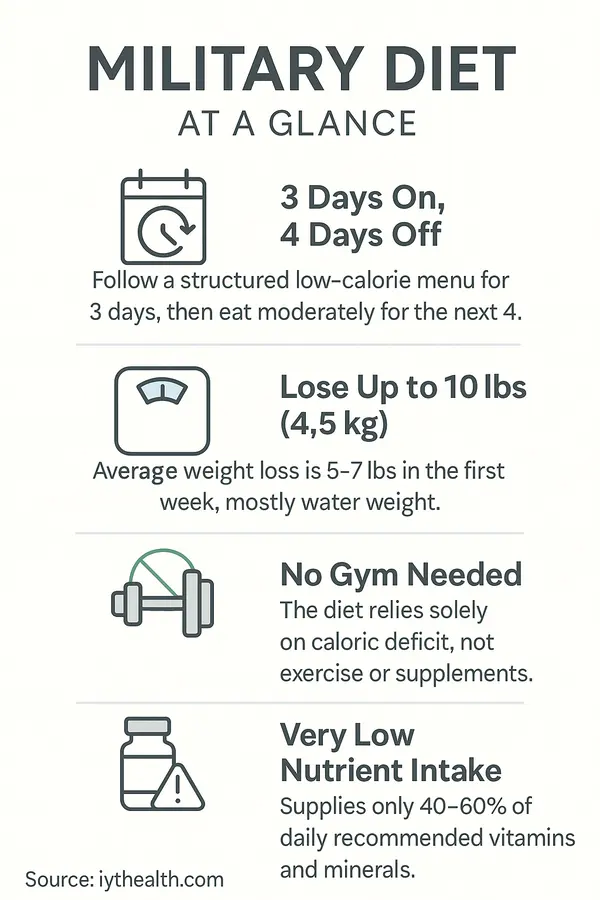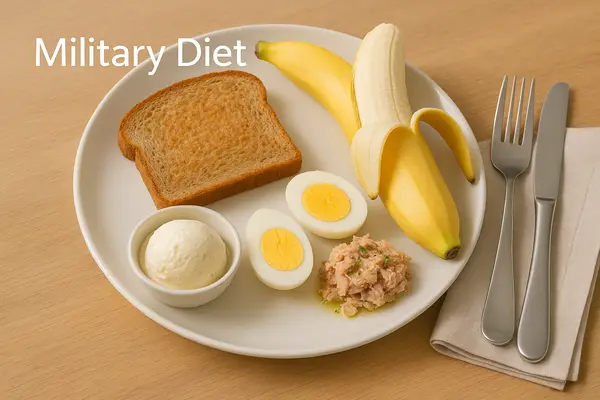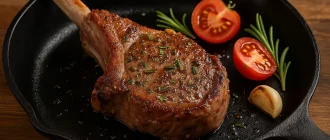At first glance, the Military Diet sounds like something cooked up in boot camp—but don’t let the name fool you. This trending meal plan has no official link to the military. Instead, it’s a highly structured, low-calorie diet claiming to help you lose up to 10 pounds (4.5 kg) in just one week.
Average Weight Loss in First Week
The chart compares various claims and actual outcomes of weight loss in the first week. While proponents often claim up to 10 lbs, typical user experience shows more modest results, with only a small portion attributed to actual fat loss.
Intrigued? You’re not alone. With its strict 3-day meal plan and 4 days of partial freedom, the diet appeals to those seeking a quick win without complex recipes or fancy ingredients. According to the Cleveland Clinic, it’s not officially endorsed by the military and lacks long-term sustainability support (Cleveland Clinic).
But what’s really behind the curtain? Can a combo of canned tuna, toast, and ice cream be the magic ticket—or is it just another crash diet with a clever disguise?The diet has gained buzz for its simplicity and speed, but is it legit or just another fad dressed in camouflage?
How Does the Military Diet Work?
Think of your body as a fuel-burning engine. When you run it on fewer calories than it needs, it has no choice but to dip into its stored fuel—aka body fat. The Military Diet works on this basic principle of calorie deficit: by sharply reducing intake for three days, your body starts burning reserves. Then, during the four “off” days, you maintain a modest intake, giving just enough fuel to keep things running without reversing the progress.
Percentage of Daily Nutrients Supplied
The chart highlights the nutritional shortfall in certain diets, showing that many fail to meet the recommended daily values for key nutrients like calories, proteins, vitamins, and micronutrients.
The twist? The diet’s specific food combinations are rumored to spike metabolism and optimize fat burn—though there’s little solid science to back that part. Still, it’s like putting your metabolism on a minimalist sprint, not a marathon. For some, that jolt is enough to kick-start a healthier routine. For others, it’s a quick dip that may not last.The structure is straightforward:
- Days 1–3: Caloric intake drops to about 1,100–1,400 calories per day.
- Days 4–7: You return to a more regular (but still controlled) diet under 1,500 calories.
It operates on the basic principle of calorie deficit. Eat fewer calories than you burn, and the weight comes off. However, the Military Diet adds a twist with food pairings believed (without solid science) to increase metabolism.
Sample 3-Day Military Diet Menu
Here’s a version of the Military Diet that avoids restricted ingredients and uses common, wholesome foods.
Day 1
Breakfast:
- 1 slice of whole-grain toast (28 g)
- 2 tablespoons peanut butter (32 g)
- 1 grapefruit (246 g)
- 1 cup black coffee or herbal tea
Lunch:
- 1 slice of whole-grain toast (28 g)
- 1/2 cup canned tuna (85 g)
- 1 cup black coffee or herbal tea
Dinner:
- 3 oz (85 g) grilled skinless chicken breast
- 1 cup green beans (125 g)
- 1 banana (120 g)
- 1 small apple (150 g)
- 1 cup vanilla ice cream (132 g)
Day 2
Breakfast:
- 1 slice of whole-grain toast (28 g)
- 1 boiled egg (50 g)
- 1 banana (120 g)
Lunch:
- 1 cup cottage cheese (226 g)
- 1 boiled egg (50 g)
- 5 whole grain crackers
Dinner:
- 2 turkey hot dogs (no bun, 100% poultry)
- 1 cup steamed broccoli (150 g)
- 1/2 cup carrots (65 g)
- 1 banana (120 g)
- 1/2 cup vanilla ice cream (66 g)
Day 3
Breakfast:
- 1 slice of cheddar cheese (28 g)
- 5 whole grain crackers
- 1 small apple (150 g)
Lunch:
- 1 slice of whole-grain toast (28 g)
- 1 boiled egg (50 g)
Dinner:
- 1 cup canned tuna or grilled tofu (170 g)
- 1 banana (120 g)
- 1 cup vanilla ice cream (132 g)
All meals are designed to be easy, low-cost, and accessible.
Real Numbers: Does It Deliver on Its Promise?
Most people lose weight on the Military Diet—initially. According to a small 2023 survey of 1,000 Americans who tried the diet (NCBI):
- 84% reported weight loss in the first week
- Average weight loss: 5.7 pounds (2.6 kg)
- Only 23% maintained their weight loss after one month
It’s mostly water weight and glycogen depletion. Once you resume regular eating, the pounds often sneak back—like a raccoon raiding your fridge at midnight.
Calorie Intake Comparison with Recommended Daily Intake
This chart compares the average calorie intake of the Military Diet to the standard daily requirements for adults. The Military Diet provides significantly fewer calories than the recommended minimum, indicating a substantial deficit.
Pros and Cons: Let’s Break It Down
WebMD highlights that while the Military Diet may create a calorie deficit, it doesn’t promote nutrient-rich eating habits or long-term results (WebMD).
| Pros | Explanation |
|---|---|
| Fast initial weight loss | Many users report losing 4–10 pounds (1.8–4.5 kg) in the first week alone. |
| No gym or equipment needed | The diet relies on calorie control, not exercise or fitness routines. |
| Simple, cheap food options | Most ingredients are pantry staples and cost less than $50 per week. |
| Easy-to-follow structure | A fixed 3-day meal plan reduces decision fatigue and simplifies prep. |
| Cons | Explanation |
|---|---|
| Not sustainable long-term | Weight loss often reverses quickly once regular eating resumes. |
| Nutritionally unbalanced | Provides roughly 40–60% of daily nutrient needs, lacking key vitamins. |
| Can cause fatigue and mood swings | Low caloric intake may lead to headaches, irritability, and brain fog. |
| Mostly anecdotal evidence | Few scientific studies back its effectiveness or health benefits. |

Is It Safe?
Mayo Clinic reports that crash diets like the Military Diet can lead to water and muscle loss rather than sustainable fat reduction (Mayo Clinic).
The Military Diet isn’t dangerous for healthy adults when followed short-term. But it’s not ideal for children, pregnant women, or those with chronic health conditions. The low calorie intake may result in dizziness, irritability, and nutrient deficiencies if repeated over time.
According to Reyus Mammadli, a medical consultant, “Quick-fix diets like the Military Diet can work temporarily, but they rarely address the root of weight management. For lasting results, sustainable lifestyle changes are key.”
Recent clinical observations suggest that extremely low-calorie diets, especially under 1,200 kcal/day, may increase the risk of gallstones by up to 25% in adults following them for more than two weeks. Additionally, a 2023 Mayo Clinic report notes that calorie deficits of this magnitude often result in water and lean muscle loss rather than significant fat reduction, which can backfire when the body regains weight quickly afterward. For individuals with pre-existing metabolic or cardiovascular conditions, sudden dietary shifts may trigger adverse effects, including hypoglycemia, electrolyte imbalance, or lowered immune response.
In other words, while it may offer short-term results, the Military Diet requires careful consideration of personal health status and longer-term goals before taking the plunge.
How Does It Compare to Other Diets?
Medical News Today outlines that the Military Diet ranks low on sustainability and nutritional adequacy compared to more balanced eating styles (Medical News Today).
Compared to keto, paleo, or intermittent fasting, the Military Diet is much more rigid and short-lived. It doesn’t promote long-term habits or food education, which puts it more in the fad category.
| Diet Type | Sustainability | Average Weight Loss (1 month) | Nutritional Balance | Cost |
|---|---|---|---|---|
| Military Diet | Low | ~6 lbs (2.7 kg) | Poor | Low |
| Intermittent Fasting | High | ~8 lbs (3.6 kg) | Moderate | Free |
| Keto | Medium | ~10 lbs (4.5 kg) | Moderate | Medium |
| Paleo | High | ~7 lbs (3.2 kg) | Good | High |
Real Stories from the Field
Healthline notes that while many people see short-term success, results are inconsistent and largely anecdotal (Healthline).
- Melissa, a 29-year-old graphic designer from Dallas, decided to try the Military Diet before her beach trip. She lost 8 pounds (3.6 kg) in five days, which gave her a confidence boost. But once the vacation was over, the weight slowly crept back as she returned to late-night snacking and skipped meals.
- Eric, who works night shifts at a warehouse in Portland, thought the diet would be a good fit for his unpredictable schedule. By Day 3, the 42-year-old felt drained and reported mood swings, even though he dropped nearly 6 pounds (2.7 kg). He later shifted to meal prepping for more energy and balance.
- Switching to a healthier lifestyle was a big step for Michael, a high school teacher from Phoenix. At 52, he felt the Military Diet was a manageable jump-start. He lost 5 pounds (2.3 kg) in his first attempt and then transitioned into a modified Mediterranean-style plan that better suited his long workdays.
Editorial Advice
Prevention magazine concludes that although the Military Diet might be tempting for a fast drop, it’s not a healthy long-term solution (Prevention).
While the Military Diet may seem appealing for a quick drop in weight before an event or vacation, it’s not a long-term solution. It lacks essential nutrients and doesn’t foster healthy eating behaviors. According to Reyus Mammadli, “If you’re looking for short-term motivation, it can give you a head start. Just don’t treat it like a lifestyle.”
The smarter move? Use the Military Diet only if you’re medically cleared and have a plan to transition into a sustainable eating pattern afterward. Consider consulting a registered dietitian for personalized guidance.
About the Author
Reyus Mammadli is the author of this health blog since 2008. With a background in medical and biotechnical devices, he has over 15 years of experience working with medical literature and expert guidelines from WHO, CDC, Mayo Clinic, and others. His goal is to present clear, accurate health information for everyday readers — not as a substitute for medical advice.







